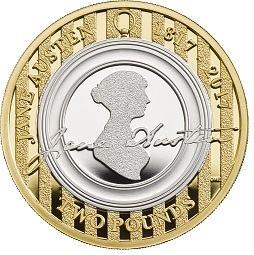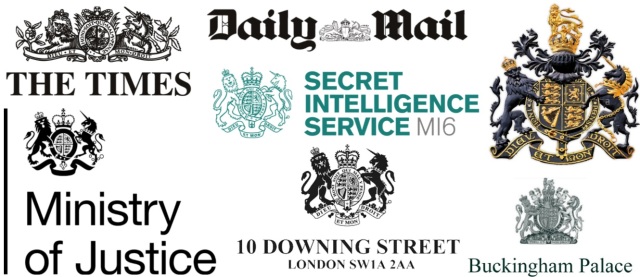Posts Tagged ‘2017’
UPDATED: Commemorative 50p Coin Mintages
Earlier in the year, we updated our Change Checker Guide to UK Commemorative Coin Mintages which included details of all the coins issued into circulation in 2017.
But The Royal Mint has just updated its mintage figures for 2017-dated 50p coins.
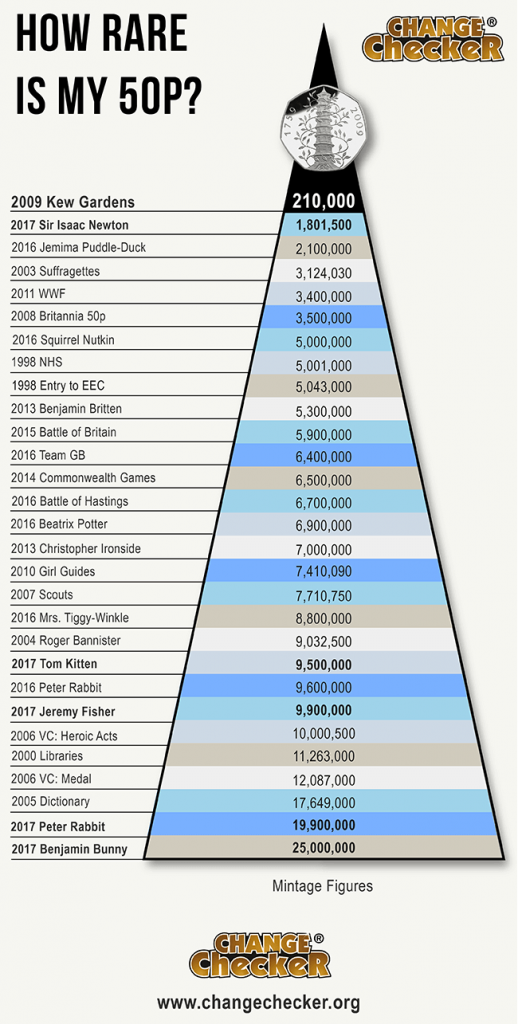
It won’t be a surprise that the 2009 Kew Gardens remains king of the 50p coins, but owners of the 2017 Sir Isaac Newton 50p will be glad to hear that the coin has managed to keep its sought-after 2nd place position on the chart. However, the final mintage has crept up by 1,500 bringing the total to 1,801,500
Whilst all four Beatrix Potter 50ps already had fairly high mintages when the figures were first revealed, the final mintages have since increased, the obvious change being the 2017 Benjamin Bunny 50p which has more than doubled. It has been confirmed that further Benjamin Bunny 50ps went into circulation during 2018, bringing the total mintage to 25,000,000.
Want to add the 2017 Jane Austen £2 to your collection?
Own it today in Brilliant Uncirculated quality. Secure yours here >>
What are ‘The Queen’s Beasts’ and why do they feature on the new £5 coins?
In 2017, The Royal Mint revealed a series of brand new base metal UK £5 coins featuring an intriguing range of creatures called the ‘Queen’s Beasts’.
After all 10 beasts were released, The Royal Mint struck a final coin as the perfect way to celebrate the series as a whole.
2021 UK Queen’s Beasts £5
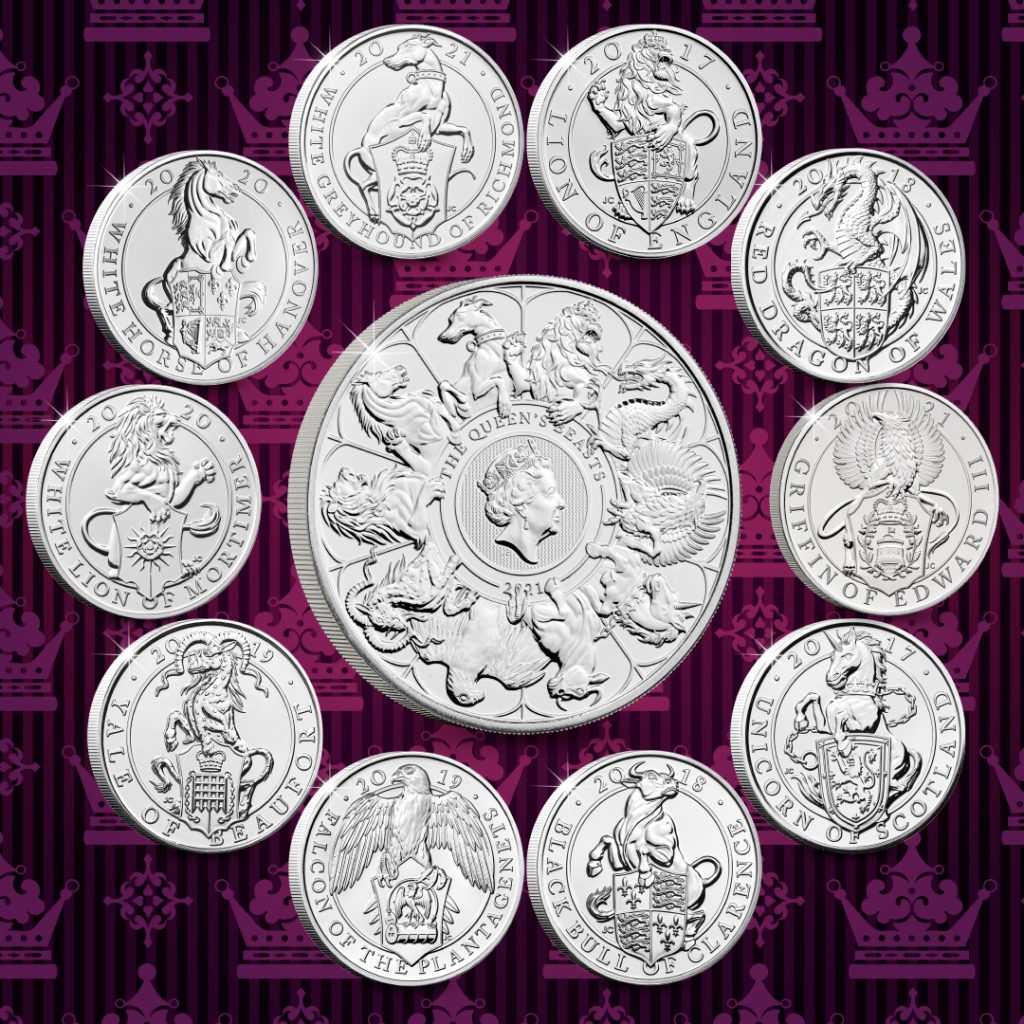
Designed by acclaimed Royal Mint engraver, Jody Clark, the reverse of this coin features not just one, but ALL TEN beasts together on a single coin to celebrate the series as a whole.
The design features each heraldic creature from the series in a striking illustration of Her Majesty’s royal line of descent.
Recognisable as national symbols and representations of the great houses that vied for the throne, the Beasts include lions, a bull, a falcon, a horse and a greyhound, as well as creatures of myth and legend.
This coin is now OFF SALE AT THE MINT, so don’t miss the chance to secure yours in superior Brilliant Uncirculated quality here >>
Or why not view the full range of coins and fill the gaps in your Queen’s Beasts collection here >>
Why “The Queen’s Beasts”?
Over 400 years ago Henry VIII commissioned the sculpting of 10 heraldic animal statues. They were produced to represent the ancestry of King Henry VIII and his third wife Jane Seymour. These became known as “The King’s Beasts” and can still be seen to this day, guarding the main entrance to Hampton Court Palace.
In 1952, in preparation for the coronation of Queen Elizabeth II, sculptor Sir James Woodford was tasked to create ten new statues, similar to “The King’s Beasts” but more suited to the Queen. Woodford was instructed not to produce exact replicas to those at Hampton Court Palace as some of them would have had little connection with Her Majesty’s own family or ancestry.
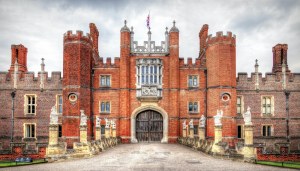
As the Queen arrived for her coronation at Westminster Abbey, she was greeted by 10 six-foot tall beasts each representing a different part of her genealogy and thus “The Queen’s Beasts” were born.

The 10 beasts were made up of ‘The Lion of England’, ‘The White Greyhound of Richmond’, ‘The Yale of Beaufort’, ‘The Red Dragon of Wales’, ‘The White Horse of Hanover’, ‘The White Lion of Mortimer’, ‘The Unicorn of Scotland’, ‘The Griffin of Edward III’, ‘The Black Bull of Clarence’ and ‘The Falcon of the Plantagenets’.
After the coronation, the beasts were offered to Canada as a gift. The Canadian government accepted and the beasts can still be seen today on display in the Canadian Museum of History.
The Queen’s Beasts in modern culture
Still to this day, the Queen’s Beasts play a hugely important part in British culture, in particular The Lion of England and The Unicorn of Scotland.
For example, they feature in the logos of some of our country’s most famous and important institutions, most notably The Royal Arms, 10 Downing Street and Buckingham Palace.
Now that you know about the history of these heraldic creatures, take a look around and you’ll be surprised how often you see them being used in everyday life.
Secure the 2021 UK Queen’s Beasts £5 for your collection today for £24.99 (+p&p)
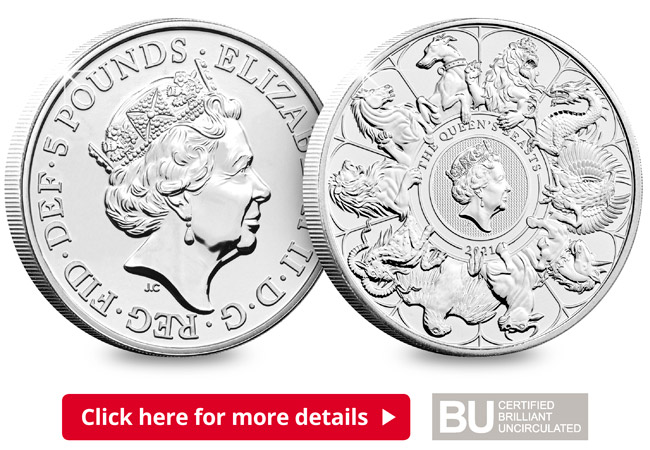
The Queen’s Beasts coins have proved incredibly popular with collectors since the very first issue and as we see the release of the final coin I wouldn’t delay in securing one for your collection today.
Your coin has been struck to a superior Brilliant Uncirculated quality, ensuring its quality is perfect for you to add to your collection. It will also come protectively encapsulated in official Change Checker packaging to preserve it for generations to come.
To secure the 2021 UK Queens Beasts £5 for your collection whilst stocks last, click here >>
The end of an era for Belgium’s Royal Mint
After 185 years of production, The Royal Mint of Belgium is set to close forever.
The Royal Mint of Belgium struck its first coins in 1832, just two years after the institution was founded, but the long standing mint will cease operations forever on January 1st 2018.
From the end of the 1990’s the Belgian Mint started producing euro coins ready for the switch from the Belgian Franc to the euro at the start of 2002. And the nation considers itself one of the pioneers with regards to the introduction of the euro as it was Belgian chief engraver Luc Luycks who designed the obverse side of all euro coins.
Unfortunately the Federal Government feels it has become too expensive for the Royal Mint to carry on producing coins itself and has decided that a private company should produce Belgian euro coins. And with more and more people paying electronically there is less and less need for coins.
Instead, the task of striking coins is being outsourced to a private company in an effort to save money.
The Royal Belgium Mint caused a stir back in 2015 when they issued a €2.50 coin to commemorate the 200th anniversary of Napoleon’s defeat at Waterloo after France forced it to scrap a €2 coin with the same purpose.
Paris objected to the Belgian coin, commemorating the French emperor’s defeat by British and Prussian forces, branding the commemoration of Waterloo as a “symbol that is negative” which would “undermine the unity of the Eurozone.”
Belgium was forced to get rid of about 180,000 €2 coins that had already been minted after Paris sent a letter saying they could cause an “unfavourable reaction in France”.
But Belgium managed to skirt the French protests by taking advantage of a European rule stating that Eurozone countries are permitted to approve their own coins without approval of other member states, providing the new denomination as an irregular one. In this case the irregular denomination was €2.50.
The Royal Belgium Mint strikes more than 40 million coins a year but the final batch of commemorative coins have now been minted, ready to close its doors in just over a month.

The last coins ever struck at The Royal Belgian Mint – issued to celebrate the 200th Anniversary of Ghent University.
The last coins ever struck at The Royal Belgian Mint were the special €2 coins issued to celebrate the 200th Anniversary of Ghent University.
The special coin features an engraved logo of the University of Ghent with the dates 1817-2017. The Belgian mintmark, a helmeted head of the archangel Michel, as well as the mintmaster mark, the armorial bearings of Herzele city, are located respectively on the right and on the left of issuing country indication ‘BE’ (meaning Belgium). The12 stars of the European flag are represented on the external ring of the coin.
Own the last coin struck at the Royal Mint of Belgium – limited availability
 We have been able to secure a very limited number of the last ever coins struck at the Royal Mint of Belgium Mint
We have been able to secure a very limited number of the last ever coins struck at the Royal Mint of Belgium Mint
They are available now for just £15.95. Click here to reserve yours >>

